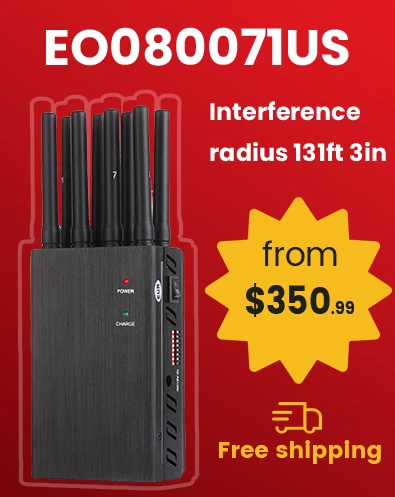The regulatory bodies responsible for regulating the use of signal jammers in the Netherlands are the Netherlands Authority for Consumers and Markets (ACM) and the National Agency for Radio Frequencies (ANFR). The ACM is responsible for ensuring compliance with telecommunications rules, while the ANFR is responsible for allocating radio frequencies.
Cell Signal Blocker and Jammer Device in Netherland
The Netherlands has several mobile operators covering the entire country. To effectively block mobile phone signals, it is essential to know the frequency bands used by these operators. In this article, we will introduce you to the main operators in the Netherlands and the frequencies they currently use.Major operators such as KPN, Vodafoneziggo and T-Mobile Netherlands use specific frequencies to provide mobile phone services. By targeting the appropriate frequency bands, you can effectively interfere with mobile phone signals in your environment, but don't forget to comply with local regulations.
Many providers use the GSM and UTMS standards, offering a wide range of options for everyone. All frequencies allow you to handle calls, send messages and perform other actions. Typically, UTMS frequencies are designed to access the third generation of the Internet. Higher frequency fourth generation communications are also available. Many providers offer a wide range of services.
In the Netherlands, there is no legal authorization for the use of signal jammers. The only exceptions are law enforcement and intelligence services, which can use signal jammers for national security reasons. However, these services must also obtain special authorization before using such devices.
The Dutch telecom market is dominated by several large operators that provide mobile communications, fixed broadband and TV services, with extensive 4G LTE coverage and the launch of 5G networks in major cities.
The following are the main telecom operators in the Netherlands:
KPN is the largest telecommunications operator in the Netherlands with a long history and is one of the main network infrastructure providers in the Netherlands. They provide mobile phone services under their own name and under subsidiary brands such as Simyo and Telfort. KPN's 4G network covers the whole country with high signal stability and quality, and has launched 5G services in major cities and high-traffic areas.
KPN mainly uses the following frequency bands:
- GSM:900 MHz and 1800 MHz
- UMTS/WCDMA: 2100 MHz
- LTE (4G):800 MHz、1800 MHz、2100 MHz、2600 MHz
- 5G:700 MHz、3500 MHz
T-Mobile Netherlands is the third largest mobile operator in the Netherlands and is part of the German telecommunications group Deutsche Telekom. It is the largest company providing a wide range of telecommunications services. The 4G network covers the entire Netherlands, and 5G networks have been deployed in major cities such as Amsterdam, Rotterdam and The Hague, gradually expanding coverage. T-Mobile Netherlands is a well-known mobile operator in the country.
They use the following frequencies:
- GSM:900 MHz and 1800 MHz
- UMTS/WCDMA: 2100 MHz
- LTE (4G):800 MHz、1800 MHz、2100 MHz、2600 MHz
- 5G:700 MHz、3500 MHz
Vodafoneziggo is another major mobile phone company in the Netherlands. VodafoneZiggo is a joint venture between Vodafone of the UK and Liberty Global of the US. It integrates Vodafone's mobile network and Ziggo's fixed network.
The frequency bands used by Vodafoneziggo include:
- GSM:900 MHz and 1800 MHz
- UMTS/WCDMA: 2100 MHz
- LTE (4G):800 MHz、1800 MHz、2100 MHz、2600 MHz
- 5G:700 MHz、3500 MHz
There are also many virtual mobile network operators (MVNOs) in the Netherlands, such as Simyo, Lebara and Youfone. These MVNO operators usually rent network resources from KPN, VodafoneZiggo or T-Mobile, providing flexible package options and lower prices, suitable for different types of users.
Frequencies that need to be blocked to interfere with mobile phone signals:The three major operators in the Netherlands have begun to deploy 5G networks in major cities and high-demand areas, and the government plans to gradually allocate higher frequency bands to support the development of a wider range of 5G networks. The 700 MHz band has been widely used for initial 5G coverage, and the 3.5 GHz band is used for higher-speed urban 5G networks.
In order to effectively block mobile phone signals in the Netherlands, it is recommended to target the frequency bands most commonly used by operators.
These frequencies include:- GSM:900 MHz and 1800 MHz
- UMTS/WCDMA: 2100 MHz
- LTE (4G):800 MHz、1800 MHz、2100 MHz、2600 MHz
- 5G:700 MHz、3500 MHz
Major operators provide 4G networks through the 800 MHz, 1800 MHz and 2600 MHz bands, while 5G services mainly rely on the 700 MHz and 3.5 GHz bands. KPN, VodafoneZiggo and T-Mobile all have high-quality networks, and users can choose the appropriate operator based on coverage and services. By locking these frequency bands, you can effectively interfere with mobile phone signals in the area. But please note that when using any signal blocking equipment, be sure to comply with local laws and regulations.
Our frequency checker tool will help you check all frequency bands used in all country.







